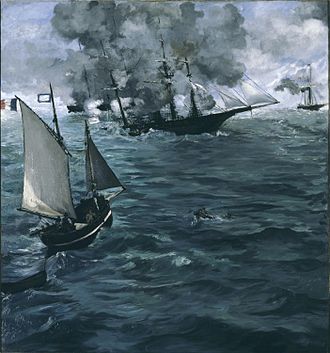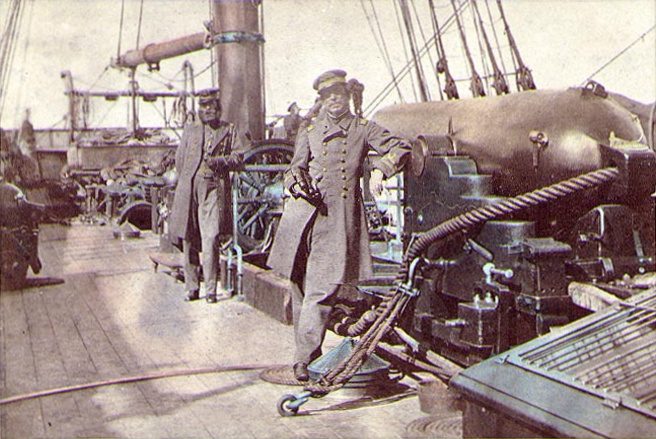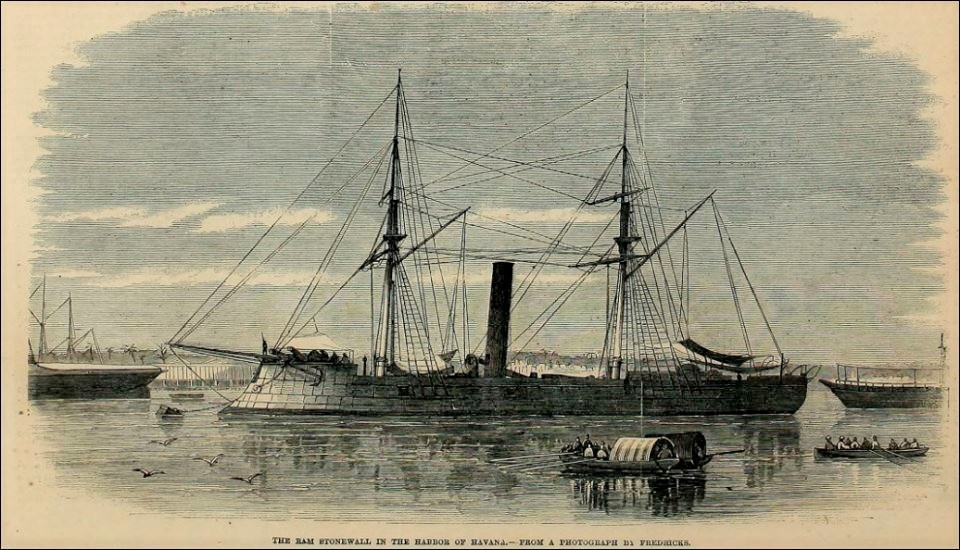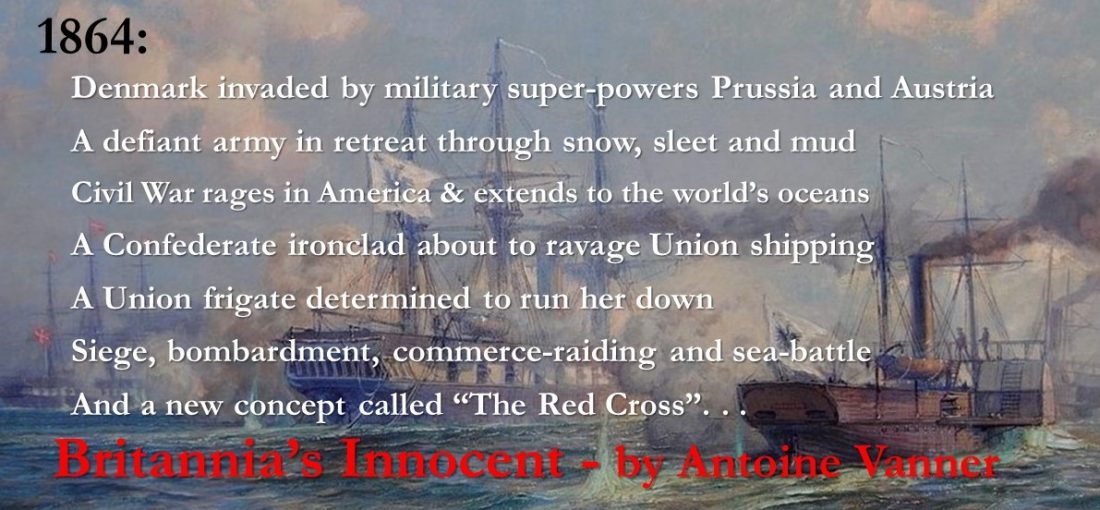From Rebel to Samurai – the epic career of the Confederate ironclad Stonewall – Part 2
Part 1 of this article told of the genesis of the ironclad, CSS Stonewall. To read it, click here.

The Alabama/Kearsarge action by Édouard Manet
A major role is played in my new novel, Britannia’s Innocent, (click here, or at end of article, for details) by a Confederate warship constructed in Britain during the American Civil War. A number of such vessels were built in European yards as part of a programme masterminded by James Dunwoody Bullock, described by Union officials as “The most dangerous man in Europe” and uncle of the future President Theodore Roosevelt. Operating as commerce raiders striking at Union shipping, the most successful of these vessels was the CSS Alabama, built in Birkenhead, England, and largely manned by British seamen.
The CSS Alabama’s raiding career, which had ranged over the Atlantic, Pacific and Indian Oceans, ended when she was run down and sunk by the Union sloop-of-war USS Kearsarge just outside Cherbourg, France, in June 1864. Édouard Manet painted the scene, showing in the foreground one of the French pilot boats that went out to see the duel and pick up survivors. The CSS Alabama had captured or burned 65 Union merchantmen, and had taken over 2000 prisoners, without causing a single loss of life. Her captain, Raphael Semmes (1809-1877) was seen as the personification of courage, competence and chivalry.

Captain Raphael Semmes on board the CSS Alabama – the Beau Ideal of a naval officer
Perhaps the most spectacular of all the European-built raiders was the CSS Stonewall, the complicated story of subterfuges that had disguised her construction and commissioning being told in the first part of this article. The end of Part 1 left the CSS Stonewall at sea after leaving Copenhagen, Denmark, in early January 1865 and now commissioned into Confederate service under Captain Thomas Jefferson Page (1808 – 1899). These events had not gone unnoticed by Union agents and diplomats and once intelligence was obtained of the CSS Stonewall’s “breakout” from the Baltic to the North Sea, and on to the Atlantic, powerful Union Navy units were despatched to find and sink her. There are strong parallels with the breakout of Germany’s battleship Bismarck in 1941 and her hunting by Royal Navy forces. Among the Union ships deployed were the steam-sloop USS Kearsarge – recently the victor of her duel with the CSS Alabama – and her sister USS Sacramento, supported later by the steam-frigate USS Niagara. Though the Kearsarge had been partly protected by improvised chain-armour, all these ships would have been at a decided – and perhaps fatal – disadvantage in any duel with the heavily-armoured CSS Stonewall.
Once at sea the CSS Stonewall developed a leak – it is notable that her now-Prussian sister Prinz Adalbert deteriorated so rapidly that she was taken from service in 1871. She put in at Quiberon, on France’s Brittany coast, where repair possibilities see to have been limited, and to take on supplies and further crew members. It is likely that many of these recruits were not American, as was the case also with other Confederate raiders, but men of other nationalities who were attracted by pay and by the opportunity for adventure. CSS Stonewall now pressed on to Ferrol, in North-West Spain, where she could undertake repairs. She remained there for almost two months. Word of her presence spread and the USS Sacramento and USS Niagara took up station outside. (One is reminded of HMS Shannon lying off Boston in 1813, daring the USS Chesapeake to come out).
 A gun exposed on an open deck on the USS Kearsarge during her duel with the CSS Alabama.
A gun exposed on an open deck on the USS Kearsarge during her duel with the CSS Alabama.
It is clear that such ships would be at a disadvantage when facing a heavily armoured
vessel like the CSS Stonewall with its weapons sheltered behind 5-inches of iron plate.
When the CSS Stonewall did finally emerge from Ferrol on 24th March, the Union warships waiting for her declined to engage – wisely, in view of the disparity in armament and armour. Captain Page now headed for Lisbon, Portugal, to take on coal prior to a dash across the Atlantic to attack Port Royal in South Carolina, the supply base for the Union General Sherman’s army. The CSS Stonewall was followed into port at Lisbon by the USS Sacramento and USS Niagara – which under neutrality rules could only glower at their Confederate opponent. An attempt by the USS Niagara to shift her berth was interpreted by the Portuguese authorities as a potentially hostile move against the CSS Alabama. Warning shots from cannon on the castle of Belem put an end to the manoeuvre. Formal neutrality rules – demanding that enemy ships could not leave harbour simultaneously – were strictly applied by the Portuguese and the CSS Stonewall slipped away unmolested.
 Portuguese battery at the Belem fort at Lisbon firing warning shots to restrain the USS Niagara before the situation was defused
Portuguese battery at the Belem fort at Lisbon firing warning shots to restrain the USS Niagara before the situation was defused
Time was running out for the Confederacy however. On 9th April Lee surrendered the Army of Northern Virginia to Grant and on 26th April the only other major Confederate force was surrendered by Johnson to Sherman. (Kirby-Smith’s smaller forces did not surrender until 2nd June). By the time that Captain Page and the CSS Stonewall put in at Nassau, in the British possession of the Bahamas, on 6th May, the epic conflict had ended. The ironclad and her crew were now orphans.
Captain Page decided to take his ship to Havana, in Cuba, then still a Spanish possession. He handed her over to the government authorities there against a payment of $16,000 and paid off her crew. The Spanish in turn handed the Stonewall to the United States in return for a similar payment. A direct payment from the Union government to purchase a Confederate asset was thus avoided.

A naval orphan – the Stonewall at anchor in Havana harbour
The triumphant Union now possessed one of the most powerful warships afloat, but in the aftermath of the Civil War there was little appetite for retention of a large navy – one which had indeed grown to gigantic levels during the conflict. The Stonewall lay decommissioned at the Washington Navy Yard for some two years until it was decided to sell her.
And the buyer?
Opened up to foreign contact only thirteen years before, the Empire of Japan was engaged on a furious, and historically-unprecedented, campaign of modernisation. Its ambitions were all but boundless and acquisition of an effective navy was of the highest priority. The ex-Confederate ironclad would be ideal for their purposes.
So the Stonewall would be heading east, and under a new name would embark on the most active part of her career . . .
I’ll tell about that in a future article, which will appear soon.
The New Dawlish Chronicles novel: Britannia’s Innocent
What links war in Denmark in 1864 with the American Civil War?
The New Dawlish Chronicles novel is being published on December 8th 2019
It’s already available in paperback. It’s also available for pre-order to get it delivered automatically on your Kindle, Tablet or Phone on Dec 8th. Click as below to pre-order:
For amazon.com For amazon.co.uk For amazon.com.au


